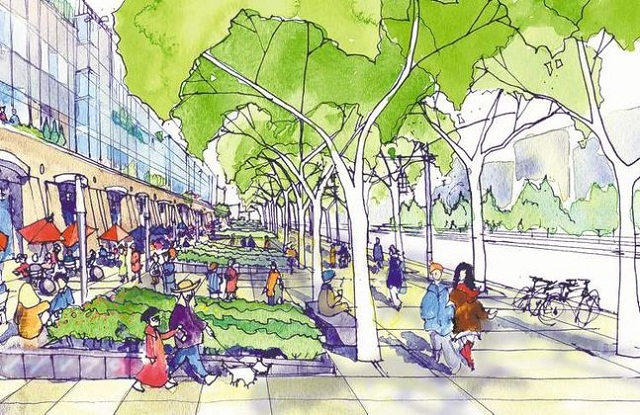There is nothing more frustrating than flying into a new city while sitting in the middle seat of an airplane. You stretch to see over the person beside you who's pressed up against the small round window. You strain to catch a glimpse of the city passing below you, trying to formulate that first impression of the place you are about to experience.
We often seem to rate the urban quality of North American cities in this way, as if we are 1,000 feet in the air. The size of its freeways or the height of its skyline resonate as symbols of civic affluence and vibrancy.

The true health of a city, however, must be judged from its sidewalks. Its urban quality can't be measured from the height of its towers. It can only be found in the spaces between those buildings. The human experience is not defined by how buildings engage the sky, but how they engage the ground, how they define public space, how they facilitate a social connection between the people in and around them.
The quality of these spaces is what makes a city livable and prosperous. Active parks, sidewalks, plazas and courtyards work together as an integrated network of open space that can attract people to live, work and invest in a city. When done well, they can be a catalyst for growth and development. When done poorly, they can enable crime and promote urban decay.
As cities look to increase density and become more sustainable, the need for quality public space has become vitally important. With this pressure, the voice of the landscape architect has become recognized as a key contributor in the design of healthy cities.
During Winnipeg's recent growth spurt, headlines have generally focused on the construction of shiny new buildings. Less celebrated has been the role landscape architecture is playing in improving our city's health and quality of life through interventions at all scales of development.
At the largest scale, landscape design is transforming Winnipeg through a complete renaissance of our neglected regional park system. The most significant project is occurring at Assiniboine Park, which is in the midst of a $200-million redevelopment that has already revolutionized the city's premier green space. Under construction is the zoo's Journey to Churchill exhibit that will become a global centre for northern wildlife education, research and conservation.
At a civic level, landscape design in Winnipeg has recently been implemented as a successful catalyst for growth and neighbourhood rejuvenation. The construction of Waterfront Drive along the Red River converted an abandoned rail line into a network of parks, plazas and pathways that provided the spark for hundreds of new residential units, stimulating the economic rehabilitation of the entire Exchange District. Further west, the redevelopment of Central Park has taken a once crime-filled, derelict urban space and transformed it into a proud neighbourhood focal point and public gathering place that has uplifted an entire community.
Landscape architects work as part of a design team to ensure buildings appropriately engage the public realm, strengthening their connection to the human scale. A successful example of this is the urban plaza that creates a transition from the stark glass walls of Manitoba Hydro Place to a sun-drenched public gathering place along Graham Avenue. Similarly, an integrated landscape design will be essential to ensure the introduction of the towering Canadian Museum for Human Rights does not diminish the pedestrian scale of The Forks site. New landscapes can also redefine existing buildings, exemplified by the City Hall Plaza and Steinkopf Gardens redevelopment at the Manitoba Centennial Centre that reconnect austere modernist designs with their urban fabric.
Landscape architecture influences every part of our city, right down to our neighbourhood playgrounds, schoolyards, skate parks, wetlands and retention ponds. As their profile and public responsibility grows, it is becoming important the profession of landscape architecture regulates the skills and qualifications of those who practise in their field. For this reason, the Manitoba Association of Landscape Architects is currently working with the provincial government to secure "name-act legislation." This legislation would restrict the use of the title landscape architect to those with the education, training and qualifications defined by the association, similar to that of other design professions such as architects, engineers and planners.
Three provinces currently have similar legislation and others are progressing toward it. Professional regulation would help to ensure industry competence and ethical practice by establishing comprehensive standards that work to protect public health, well-being and quality of life, while promoting design expertise that enhances our natural environment and cultural heritage.
The design palette of a landscape architect is composed of living things; things that change each year, things that grow and die and transform through the seasons. The spaces they create redefine themselves over time. They bring us together, encourage social interaction and enhance our connection to the environment. The ability to compose these spaces with a knowledge of how they will live, grow and evolve through the years is the magic landscape architects as professional designers bring to our cities and to our lives.
Brent Bellamy is senior design architect for Number Ten Architectural Group.
Republished from the Winnipeg Free Press print edition February 4, 2013 B4

